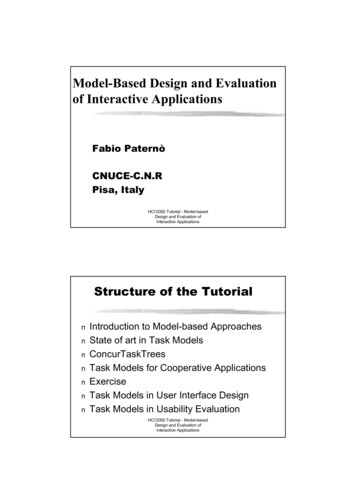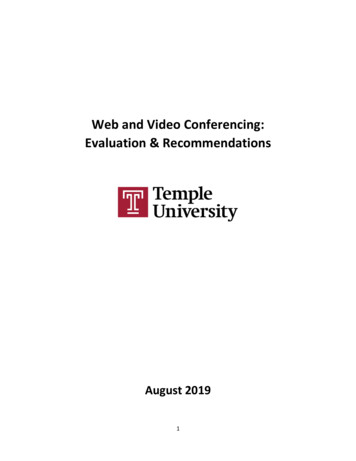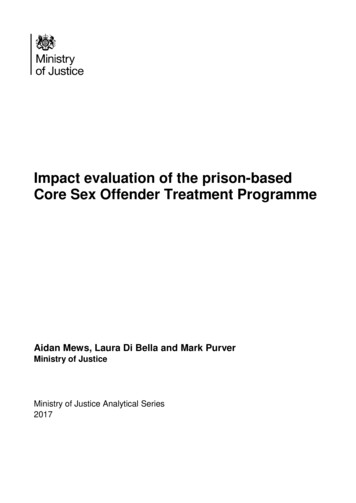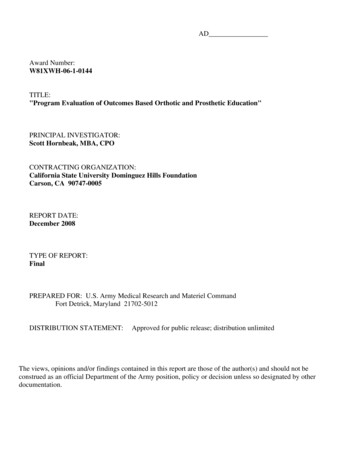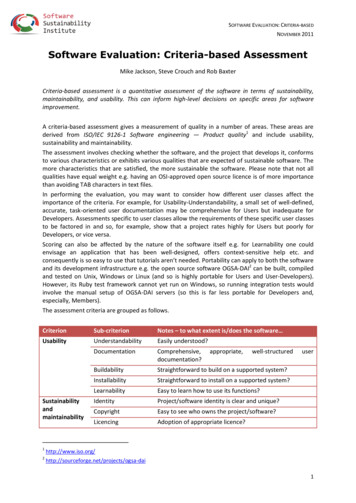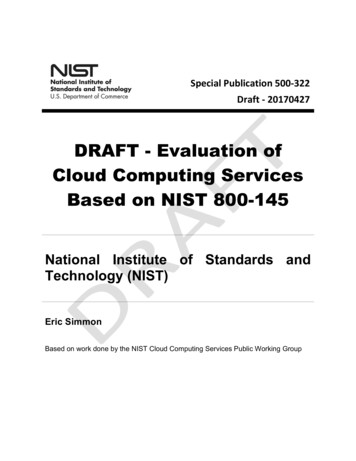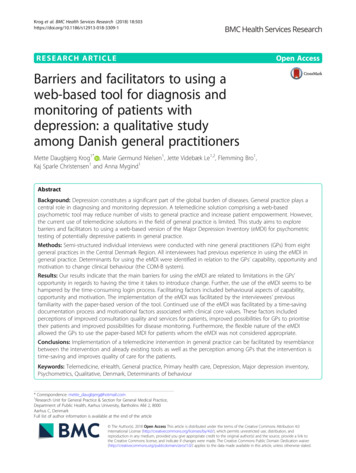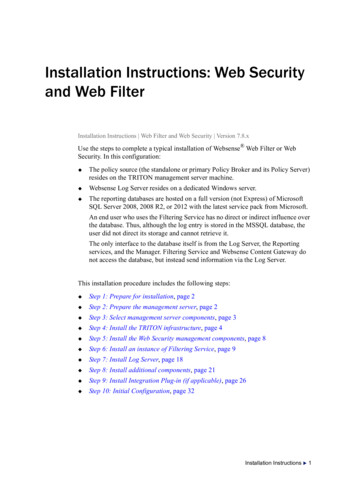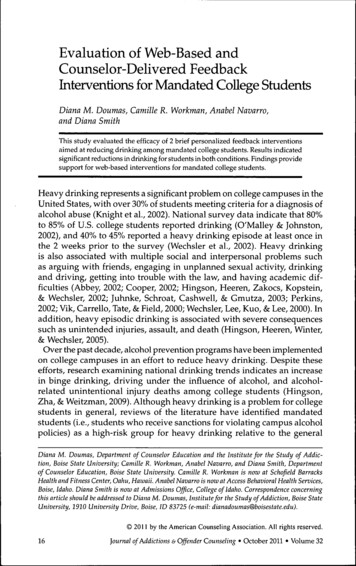
Transcription
Evaluation of Web-Based andCounselor-Delivered FeedbackInterventions for Mandated CoUege StudentsDiana M. Doumas, Camille R. Workman, Anabel Navarro,and Diana SmithThis study evaluated the efficacy of 2 brief personalized feedback interventionsaimed at reducing drinking among mandated college students. Results indicatedsignificant reductions in drinking for students in both conditions. Findings providesupport for web-based interventions for mandated college students.Heavy drinking represents a significant problem on college campuses in theUnited States, with over 30% of students meeting criteria for a diagnosis ofalcohol abuse (Knight et al, 2002). National survey data indicate that 80%to 85% of U.S. college students reported drinking (O'Malley & Johnston,2002), and 40% to 45% reported a heavy drinking episode at least once inthe 2 weeks prior to the survey (Wechsler et al., 2002). Heavy drinkingis also associated with multiple social and interpersonal problems suchas arguing with friends, engaging in unplanned sexual activity, drinkingand driving, getting into trouble with the law, and having academic difficulties (Abbey, 2002; Cooper, 2002; Hingson, Heeren, Zakocs, Kopstein,& Wechsler, 2002; Juhnke, Schroat, Cashwell, & Gmutza, 2003; Perkins,2002; Vik, Carrello, Täte, & Field, 2000; Wechsler, Lee, Kuo, & Lee, 2000). Inaddition, heavy episodic drinking is associated with severe consequencessuch as unintended injuries, assault, and death (Hingson, Heeren, Winter,& Wechsler, 2005).Over the past decade, alcohol prevention programs have been implementedon college campuses in an effort to reduce heavy drinking. Despite theseefforts, research examining national drinking trends indicates an increasein binge drinking, driving under the influence of alcohol, and alcoholrelated unintentional injury deaths among college students (Hingson,Zha, & Weitzman, 2009). Although heavy drinking is a problem for collegestudents in general, reviews of the literature have identified mandatedstudents (i.e., students who receive sanctions for violating campus alcoholpolicies) as a high-risk group for heavy drinking relative to the generalDiana M. Doumas, Department of Counselor Education and the Institute for the Study of Addiction, Boise State University; Camille R. Workman, Anabel Navarro, and Diana Smith, Departmentof Counselor Education, Boise State University. Camille R. Workman is now at Schofield BarracksHealth and Fitness Center, Oahu, Hawaii. Anabel Navarro is noiu at Access Behavioral Health Services,Boise, Idaho. Diana Smith is now at Admissions Office, College of Idaho. Correspondence concerningthis article should be addressed to Diana M. Doumas, Institute for the Study of Addiction, Boise StateUniversity, 1910 University Drive, Boise, ID 83725 (e-mail: dianadoumas@boisestate.edu). 2011 by the American Counseling Association. All rights reserved.16Journal of Addictions & Offender Counseling October 2011 Volume 32
college population (Larimer & Cronce, 2002, 2007). Studies examiningdrinking patterns on college campuses also indicate that mandated studentsdrink more heavily and report more alcohol-related problems than othercollege students (see Barnett & Read, 2005). Barnett and Read (2005) alsoindicated there has been an increase in the nimiber of alcohol-related arrests,the number of students receiving alcohol citations, and the proportion ofstudents mandated to participate in a postcitation intervention on collegecampuses. These statistics point to the importance of developing effectiveinterventions for mandated college students.Reviews of the literature support the efficacy of brief interventions forreducing heavy drinking among the general college student population(Burke, Arkowitz, & Menchola, 2003; Carey, Scott-Sheldon, Carey, &DeMartini, 2007; Larimer & Gronce, 2007; Moyer, Finney, Swearingen,& Vergun, 2002). Brief motivational interventions typically includepersonalized normative feedback, such as information about personaldrinking patterns and drinking risk status in relation to peer drinkingnormative data (Larimer et al., 2001; Marlatt et al., 1998). Over the pastfew years, innovative approaches to implementing brief motivationalinterventions have been developed, with a growing number of controlledstudies indicating that web-based personalized feedback programs areeffective in reducing drinking and alcohol-related consequences amongcollege students (see Carey, Scott-Sheldon, Elliot, Bolles, & Carey, 2009).Although research indicates feedback, whether delivered in person, bymail, or electronically, can be effective in reducing heavy drinking amongcollege students (Larimer & Gronce, 2007; Walters & Neighbors, 2005),there are many advantages to using online programs to provide normative feedback to students (Walters, Miller, & Chiauzzi, 2005). In particular,web-based interventions are easily disseminated, provide an engagingmedium for college students who enjoy "surfing the net," and are low incost compared with in-person interventions.Several randomized controlled studies have been conducted examiningthe efficacy of brief motivational interventions with mandated students(Barnett, Murphy, Colby, & Monti, 2007; Barnett et al, 2004; Borsari &Carey, 2005; Carey, Henson, Carey, & Maisto, 2009; Doumas, McKinley, &Book, 2009; White et al., 2006; White, Mun, Pugh, & Morgan, 2007). In astudy of high-risk mandated students, Borsari and Carey (2005) comparedthe efficacy of two brief in-person interventions (motivational interviewingvs. education) for reducing drinking and alcohol-related problems amongmandated students. Results at a 6-month follow-up indicated both groupsdecreased their binge drinking, and the motivational intervention groupshowed a significantly higher reduction in alcohol-related problems thanthe education group. Similarly, Doumas et al. (2009) compared the efficacy of two web-based interventions (personalized normative feedbackvs. education) for reducing drinking and alcohol-related problems amongmandated students. Results of a 30-day follow-up indicated mandatedjournal of Addictions & Offender Counseling October 2011 Volume 3217
students in the personalized normative feedback condition reported significantly greater reductions in all drinking measures than students in theeducation condition. Although not significant, a similar trend was foundfor alcohol-related consequences.In a larger study with a longer follow-up period, Barnett and colleagues(see Barnett et al., 2007; Barnett et al., 2004) examined the efficacy of twointerventions for mandated students referred to either a one-sessionbrief motivational interview (BMI group) or a 45-minute session reviewing an educational CD (Alcohol 101 group). At the 3-month follow-up,both groups decreased their drinking, although there were no changesin alcohol-related problems. Results of a 12-month follow-up, however,indicated mandated students in the Alcohol 101 group increased thenumber of drinks per drinking occasion compared with the BMI group,whereas the students in the BMI group reported an increase in drinkingfrequency compared with those in the Alcohol 101 group. In a similarstudy, Carey et al. (2009) compared students referred to a one-session BMI(BMI group) with those referred to a session reviewing an educationalCD (Alcohol 101 Plus group). Initial findings indicated female studentsin the BMI group reduced their drinking more than those in the Alcohol101 Plus group. Results of a long-term follow-up, however, indicated thatat 12 months all drinking measures had returned to baseline levels, withno differences between the groups.In another large-scale study with a long-term follow-up. White and colleagues (see White et al., 2006; White et al., 2007) examined the efficacy ofa two-session brief personalized feedback program comparing the BriefAlcohol Screening and Intervention for College Students (Dimeff, Baer,Kivlahan, & Marlatt, 1999) delivered either in an in-person motivationalfeedback session or in a written feedback condition. At 3-month follow-up,both groups decreased the total number of drinks per week, the frequencyof binge drinking, and alcohol-related problems. However, no significantdifferences were identified between the in-person feedback and writtenfeedback conditions. Results of a 15-month follow-up assessment, however,indicated that mandated stiidents reduced their drinking and alcohol-relatedproblems from the baseline assessment, and this reduction was primarilyaccounted for by the students in the in-person motivational feedback session (White et al., 2007).The growing body of research examining interventions with mandatedstudents generally supports the short-term efficacy of personalized normative feedback interventions for mandated students whether deliveredin person (Barnett et al., 2004; Borsari & Carey, 2005; White et al., 2006),by mail (White et al, 2006), or onhne (Doumas et al., 2009). Results ofstudies with longer follow-up periods, however, are inconsistent, withsome studies showing mixed effects (Barnett et al., 2007), no effects (Careyet al., 2009), or positive effects (White et al., 2007) for BMIs in the longterm. The most promising approach for follow-up periods longer than 618journal of Addictions & Offender Counseling October 2011 Volume 32
months appears to be personalized feedback delivered in-person througha motivational interview. To date, however, no studies have examinedthe efficacy of using web-based personalized normative feedback (WPF)relative to using counselor-delivered personalized normative feedback(CPF) with mandated students.The aim of the present study is to extend the literature by examining theefficacy of a web-based feedback program in reducing heavy drinking andalcohol-related problems in mandated college students. This study is uniquein that we use the same web-based feedback program for both interventionconditions, with one group of college students reviewing the feedback ontheir own (WPF group) and the other group reviewing the feedback witha counselor (CPF group). To achieve these aims, we randomly assignedmandated college students to either the WPF or the CPF condition. Wehypothesized that mandated students in the CPF condition will reportgreater reductions in drinking and alcohol-related problems comparedwith those in the WPF condition.MethodParticipantsThe participants in this study were students who were referred to University Counseling Services for violating the university policy for alcoholand other drugs. Referrals were made by staff in residence life (85.7%) andthe athletic department (14.3%). Mandated students were given an opportunity to participate in the study and were not offered compensation fortheir participation. All participants were treated according to establishedAmerican Psychological Association ethical standards, and the universityinstitutional review board approved all research procedures.Of 61 mandated students referred to University Counseling Services, 60were referred for an alcohol-related citation. Of these, four declined toparticipate in the study. Of the remaining 56 students, 61% were male and39% were female. Ages of the students ranged from 18 to 24 years (M 19.22, SD 1.30). The majority of students were European American (88%),with 6% African American, 4% Asian American, and 2% Native American.Students were primarily freshmen (72%), with 14% sophomores, 10% juniors, and 4% seniors. Participants were randomly assigned to either theWPF or the CPF condition using a computer-generated random numberstable. Thirty-two (57%) students were assigned to the WPF condition and24 (43%) students were assigned to the CPF condition. Chi-square analysesand Í tests confirmed there were no significant differences in any of thedemographic variables between the groups. A series of independent sampleÍ tests, however, indicated that students in the CPF group reported higherlevels than those in the WPF group on all of the drinking variables. Therefore,we include baseline levels of drinking and alcohol-related consequences inthe statistical analyses using a repeated measures design.Journal of Addictions & Offender Counseling October 2011 Volume 3219
MeasuresRecommendations by the National Institute on Alcohol Abuse andAlcoholism (2003) task force include assessing patterns of alcohol consumption in addition to the average number of drinks consumed andincluding at least three measures of consumption covering quantity,frequency, and heavy consumption. We included three measures of alcohol consumption: weekly drinking quantity, peak alcohol consumption,and frequency of drinking to intoxication. We also included a measureof alcohol-related consequences.Alcohol consumption. We assessed typical quantity of weekly drinking byusing a modified version of the Daily Drinking Quesfionnaire (Collins, Parks,& Marlatt, 1985). This item asks parficipants to indicate how much theytypically drink: "Given that it is a typical week, please write the number ofdrinks you probably would have each day." A response scale is providedfor each day of the week (Monday, Tuesday, etc.). Weekly drinking wascalculated by combining reports for the 7 days of the week. Peak alcoholconsumption was assessed by an item asking participants to indicate thenumber of drinks consumed on the occasion on which they drank the mostthe previous month. Frequency of drinking to intoxication was assessed bythe question, "During the past 30 days (about 1 month), how many timeshave you gotten drunk, or very high from alcohol?" This item was ratedo n a scale w i t h t h e a n c h o r s 0,1 to 2, 3 to 4, 5 to 6,7 to 8,oi 9 times.Alcohol-related consequences. We assessed alcohol-related consequences byusing the Rutgers Alcohol Problem Index (RAPI; White & Labouvie, 1989).The RAPI is a 23-item self-administered screening tool used to measureadolescent problem drinking. Participants were asked the number of timesin the past 30 days they experienced each of 23 negative consequences asa result of drinking. Responses were measured on a 5-point scale ranging from 1 (never) to 5 {more than 10 times). A total consequence score wasobtained by summing the 23 items. The RAPI assesses both traditionalphysical consequences (e.g., tolerance, withdrawal syn\ptoms, physicaldependency) and consequences presumed to occur at higher rates in a college student population (e.g., missing school, not doing homework, goingto school drunk). The RAPI has good internal consistency (Neal & Carey,2004) and test-retest reliability (Miller et al., 2002).InterventionMandated students were randomly assigned to one of two interventions: aWPF condition or a CPF condition. All participants completed the baselinequestionnaires and the computerized assessment. Those in the WPF condition reviewed the web-based feedback on their own, and those in the CPFcondition reviewed the web-based feedback with an advanced master's incoimseling graduate student trained in mofivational interviewing techniques.WPF condition. Participants in the WPF condition were directed to take eCHUG, an evidenced-based, online alcohol intervention and personalized20journal of Addictions & Offender Counseling October 2011 Volume 32
feedback tool recognized by the National Association of Student PersonnelAdministrators and developed by counselors and psychologists at San Diego State University (SDSU). This brief web-based program is designed toreduce high-risk drinking by providing personalized feedback and normative data regarding drinking and the risks associated with drinking. Theprogram is commercially available and is managed by the SDSU ResearchFoundation. Further details about the program, procedures and costs forsubscribing to the program, and supporting research are provided on theprogram's website (http: / /www.e-chug.com/). The program is customizedfor the participating university, including providing normative data for thespecific university population, providing referrals for the local community,and designing the website using university colors and logos.The personalized feedback program takes approximately 30 minutes tocomplete. Students first complete an online assessment. This assessmentconsists of basic demographic information (e.g., sex, age, weight, livingsituation, class standing) and information on alcohol consumption, drinking behavior, and alcohol-related consequences. Immediately following theassessment, individualized graphed feedback is provided in the following domains: summary of quantity and frequency of drinking includinggraphic feedback such as the number of cheeseburgers that are equivalentto alcohol calories consumed, graphic comparison of one's own drinkingto U.S. adult and college drinking norms, estimated risk status for negative consequences associated with drinking and risk status for problematicdrinking based on the participant's Alcohol Use Disorder IdentificationTest (AUDIT) score, genetic risk, tolerance, approximate financial cost ofdrinking in the past year, normative feedback comparing one's perceptionof peer drinking with actual university drinking normative data, and referral information for local agencies.CPF condition. Participants in the CPF group completed the same web-basedprogram (e-CHUG) as those in the WPF group. In addition, participantsin the CPF group reviewed their feedback with an advanced master's incounseling graduate student trained in motivational interviewing techniques. Immediately after completing the web-based program, participantsreviewed their feedback with the student counselor. The in-person sessionfocused on reviewing the feedback with the participant and discussing theparticipant's alcohol use and alcohol-related risk in relation to the peerbased normative data.ProcedureParticipants completed all procedures at University Covmseling Serviceswith an advanced master's in counseling graduate student trained in motivational interviewing techniques. Mandated students received instructions for scheduling an appointment from the source of referral and werescheduled within 2 weeks of the policy violation. During the appointment,participants were informed of the nature of the study, risks and benefitsJournal of Addictions & Offender Counseling October 2011 Volume 3221
of participation, and the voluntary nature of participation. Questionnairesat baseline were completed in written format. During the baseline datacollection, students were assigned a personal code. This code was used toidentify pre- and postintervention responses from each student, as well as tocalculate response rates from baseline to follow-up assessments. Parficipantscompleted baseline questionnaires and either the WPF or the CPF program.Once the intervention was completed, students set up an appointment fora 30-day follow-up session. The average appointment length ranged from35 to 45 minutes (M 40.88, SD 3.05) for the WPF condition and 35 to 45minutes (M 42.33, SD 2.2) for the CPF condition. During the 30-minutefollow-up session, participants completed follow-up questionnaires andthen participated in a brief session in which the master's in counselingstudent reviewed the student's current drinking and any concerns relatedto drinking. Students were provided a referral to Urüversity CounselingServices either for ongoing alcohol-related problems or for future issuesor concerns.ResultsAttritionOf the 56 participants, 37 (66%) completed the 30-day follow-up assessment.There was no difference in the rate of attrition across the two interventiongroups, x 1-80, p .15. In addition, a series of chi-square analyses andindependent sample f tests revealed no differences in demographic variablesor in any of the drinking variables between the participants who completedthe study and those who did not.Statistical AnalysesWe first examined the data for extreme cases that might affect the resultsof the analyses. Outliers were defined as thos
related unintentional injury deaths among college students (Hingson, Zha, & Weitzman, 2009). Although heavy drinking is a problem for college students in general, reviews of the literature have identified mandated students (i.e., st

